Monday, September 26, 2011
Robyn Love Interview on TCA
Conducted an interview with knit-ty multi-disciplinary artist Robyn Love last week in honour of the massive public art project that she was commissioned to do for the Cheongju International Craft Biennale. The interview was posted on TCA last Friday...read it and get inspired! http://torontocraftalert.ca/2011/09/23/questions-for-crafters-cheongju-robyn-love/
Image: Water Tower Cozy by Robyn Love, courtesy of her website.
Labels:
art heros,
community,
craft,
exhibitions,
fibre art,
installation,
public art
Tuesday, September 20, 2011
Cover Stories
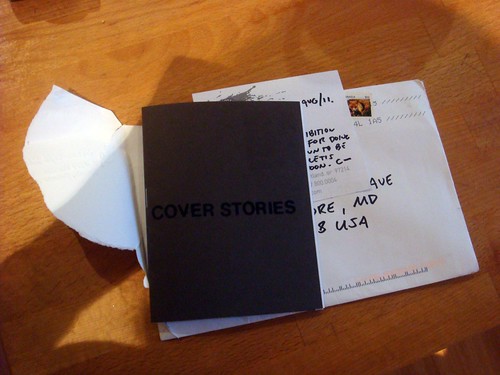
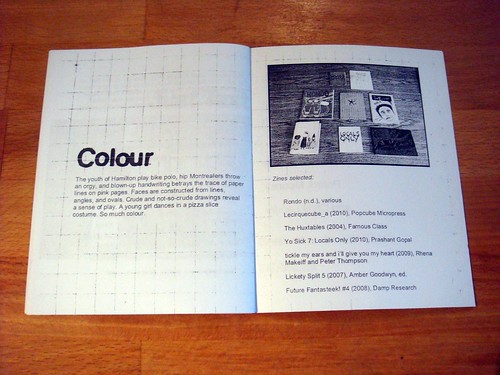
Before I left to come to Baltimore exactly one month ago, I packed my life with an unbelievable amount of projects-- mostly collaborative. Some had been in the works for a while, and I felt a real responsibility to have things finally materialize before I left town. It was also a good way to spend some time with the people I know before I left Toronto for a while.
One such project was "curating" the exhibition Cover Stories for the Toronto Zine Library. While I was asked by the TZL to curate an exhibition, it was largely a collaboration between myself and three of the members of the TZL Collective-- Lyndall, a talented lady who made a documentary about Who's Emma a few years ago; Chris, the creator of many zines over the last 10 or 15 years, at least one of which is considered a Canadian "classic"; and Patrick, who is one of the founding members of the TZL, and is a great all-round guy and an amazing baker. After being asked to help create an exhibition, I spent three or four weeks going through the library's massive collection with a fine tooth comb, picking out any zines that I liked especially, or pulling out zines that shared some sort of mutual connection. While I went into this project not having any curatorial theme in mind whatsoever, one slowly emerged. As an artist and zine-maker, I couldn't help be attracted to interesting and unique design in the zines I came across. I eventually decided that creating a narrative about zines through their covers might be a neat way to create an exhibition that, while forming physical zine "groups," doesn't claim to draw on any real fixed history of zine-making.
I eventually chose a pile of zines and divided them into 6 loose thematic groups which eventually became "Just Text," "Print Media," Colour," "Little Zines," "Hearts and Other Body Parts," and "In the Mail." Each collective member of those mentioned above chose two groups at random to write short didactic descriptions about to serve as wall text for the exhibition, interpreting the themes as they saw fit. I wrote the following summary of the exhibition:
Cover Stories is an exhibition of selections from the public collection of the Toronto Zine Library. Using thematically-grouped zine covers as a springboard, we thought it would be interesting to highlight zine art and design as a way of telling the greater story of zines– what they are, how they’ve changed over the years, and why they continue to be a valuable and relevant medium. While some selections from the library have been refashioned as photographs for this exhibition, others appear in their original form to be handled and appreciated as intimate and tactile objects. In creating this interactive exhibition, we hope that you will spend time with some of the titles on display while learning about zines as both an art form and a method of communication.
We were REALLY down to the wire with finishing work for this exhibition-- we ended up installing the show two days before I left for Baltimore! I am thrilled with how the exhibition turned out-- it was a really great collaboration, and everyone played a really important part in making it happen. Lyndall took some really fantastic pictures of the zines that were chosen for the exhibition, and Chris played a huge part in designing and assembling what ended up being a really wonderful exhibition zine/catalogue (pictured above), which will serve as a great document for after the show comes down.
Cover Stories should still be up in the Southern Cross Room of the TRANZAC Club at 292 Brunswick Avenue, in the Annex. I'm not sure when it's coming down, but if you're interested in checking it out, do so soon!
Labels:
catalogues,
curating,
exhibitions,
libraries,
print,
zines
Monday, September 12, 2011
The Feedback Quilt Project
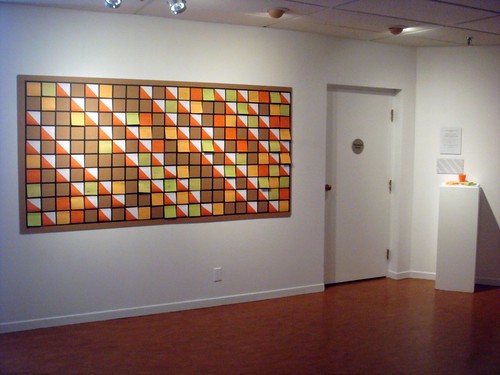
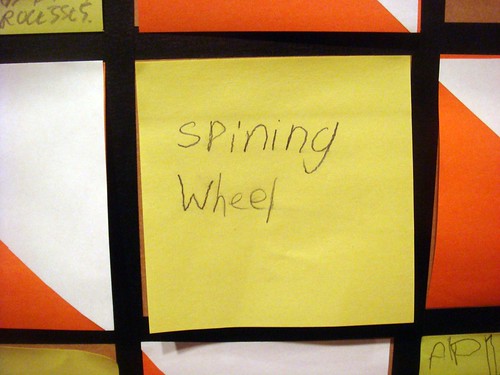


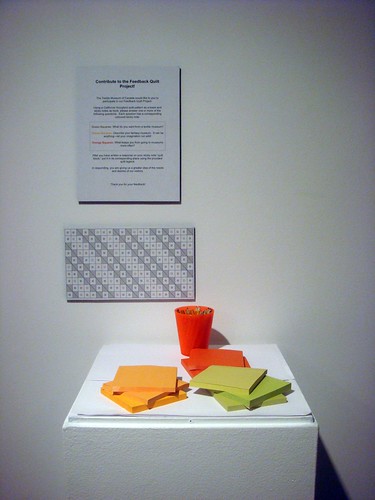
I'm going to step back in time a bit to post some documentation of a participatory activity I designed for the TMC that was up in the museum for the month of August. The quilt was part of a larger project I did for the museum, doing qualitative research about visitor engagement and satisfaction. Inspired by some of the ideas in Nina Simon's book, The Participatory Museum, I thought I would make an in-museum project that would serve as something of an interactive guestbook. Here is a short summary I wrote about the quilt that explains it a bit more. I'm happy to report that by the end of my contract on August 19th, the quilt was almost completely done!
The purpose of The Feedback Quilt Project is to create a participatory visitor feedback activity for the museum space. Its goals are to collect and preserve visitor content, to create a more interactive museum environment, to educate visitors about a particular material practice (quilt structure and construction) and to become a “town square,” essentially creating an alternative portrait of our visitorship.
A 3-colour hourglass quilt structure (http://quilting.about.com/od/blockofthemonth/ss/cal-hourglass-quilt-block_2.htm) was mapped out on an 8’ X 4’ piece of Foamcore with a 1/2", dark-coloured masking tape. The board was mounted to a wall facing the 2nd floor elevators and stairwell. The activity requires that visitors answer at least one of three questions:
1. Describe your ‘Fantasy Museum.”
2. What keeps you from going to museums?
3. What do you want out of a museum for textiles?
Each question has a corresponding coloured “quilt block” sticky note. Using a dry-mounted, colour-coded quilt legend, visitors placed a sticky note with their response in the appropriate position on the quilt template, almost like a large paint by numbers or cross-stitch kit. In doing so they are building a large quilt form together, and the more questions they respond to, the more the “quilt” starts to take shape. The quilt form was chosen as a basis for the activity due to the connections between quilting, community and communication.
Responses to this activity were revealing. Many people took the opportunity to spill their guts about what they felt museums were and weren't giving them as visitors. Many focused on the price and hours of operation of museums not being accessible. A few came up with truly amazing ideas for fantasy museums-- a museum of smells, a snowglobe museum, a "museum of everything in the entire world." I came away from the project at the end of my contract realizing that museum visitors will reveal a lot to you if you make the effort to stray away from the same old prescribed questions, such as "are you a return visitor?" and "how did you hear about our museum?"
My sincerest thanks goes out to the museum for giving me the chance to basically make art and talk to enthusiastic museum-goers and textile fans all summer. Funnest job ever!
For more documentation of the quilt, check out the TMC's fantastic Facebook Page.
Thursday, September 08, 2011
On Ownership
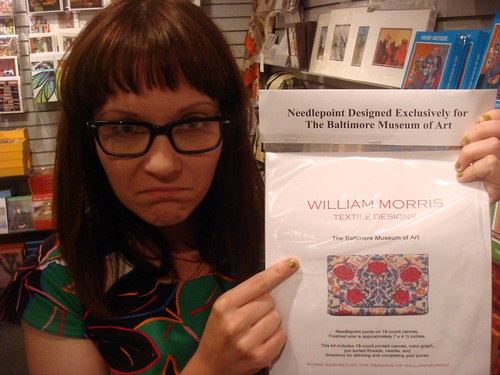
My Crossed Stitches project has officially come full circle-- someone else made a William Morris cross stitch kit, and is selling them for $82.00 at the BMA gift shop!! "Needlepoint designed exclusively for The Baltimore Museum of Art." Unbelievably annoying...but also totally hilarious and ironic.
Photo Credit: B. Needham
Labels:
craft,
cross-stitch,
galleries,
negativity,
shops,
textiles
Thursday, September 01, 2011
Heir/Looms
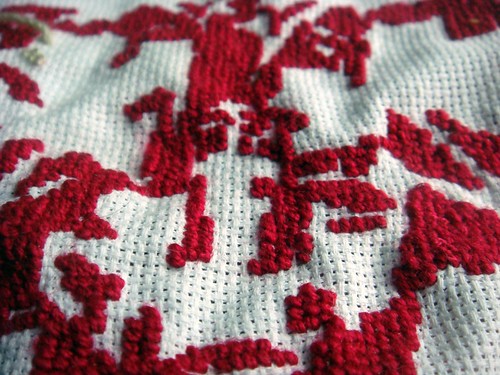
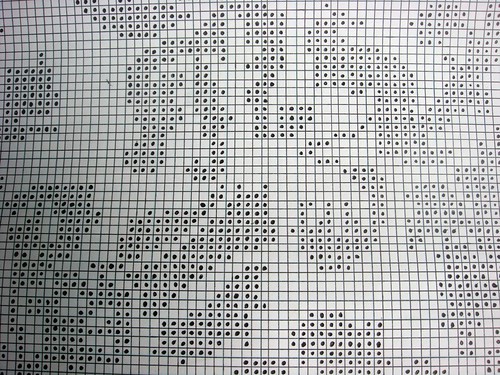
Last week, my project Crossed Stitches was included in the exhibition Heir/looms, curated by Nicole Dawkins for Studio Beluga in Montreal. The exhibition seems to have gone off without a hitch...congratulations Nicole, and thanks so much for including me!
A really gorgeous and engrossing catalogue accompanied the exhibition, packed with artist interviews, images and multiple exhibition essays. It was a real honour to be included in it. The catalogue is a super limited edition, so I thought I'd include my complete catalogue interview and artists statement here for anyone who is interested in me nattering on and on about myself and my family...
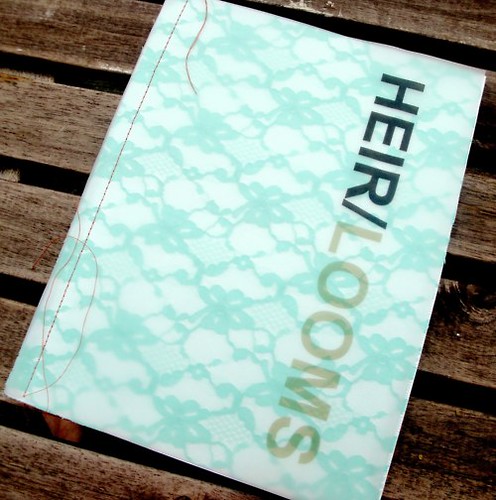
How much can we really claim to “own” our ideas? The repeating, reworking and re-contextualizing of ideas from the past is part of the postmodern condition. So many ideas have come to fruition over the course of history-- when we make something, what are the odds that it hasn’t been made before? Anyone who has come across the work of another artist that is uncannily similar to their own knows what it means to have their sense of ownership over an idea thwarted. Perhaps the solution to this dilemma is to forfeit ownership altogether.
My piece, Crossed Stitches, explores these ideas. Focussing on a wallpaper design by William Morris-- a designer whose level of influence cannot be overestimated-- I went through the painstaking process of creating an accurate and fully-functional cross-stitch pattern that corresponds to his original design. This process involved transferring each design onto a large grid and translating each pattern so that it is comprised of squares on a grid. These large-scale grid drawings were then used to make a cross-stitch pattern on another piece of grid paper, dividing the colours of the pattern into symbols as “real” cross-stitch patterns do. This final pattern was then included in hand-made cross-stitch kits, so people can make their own William Morris “fabric swatches.”
Crossed Stitches has been paired with an embroidered piece by my mother, created for me in 1989 from a commercial cross-stitch pattern from a book called Patterns From the Past. Both pieces represent different views on the issues of authorship and authenticity.
How did you come to work with fibre-based materials?
When I think back to the very first pieces of sculptural work I made as a student long ago, I remember using materials that weren't "artists" materials, probably because I wanted to make the work that I was envisioning without having the equipment, or the technical know-how attached to sculptural materials such as clay and plaster. I remember making sculptures out of crumpled up tin foil, ceramic tiles, coffee filters, paper-- materials that are very rooted in the domestic and "every day." Early on, I was inspired by artists like Robert Rauschenberg (still one of my very favourite artists), and I think this work was partially inspired by artists like him who worked with simple, cheap found materials poached from every day life. Then about 6 or 7 years ago I made a leap from attempting to make art that was like pure sculpture to making work involving garments. I would buy used garments and speculate who the owner used to be, and how the garment might be a reflection of who that person was and what they did with their lives. I would sometimes attach used garments to found old photos and create narratives with installations centred around the found garment. While this body of work didn't last long I consider it my first serious body of work, and it definitely set the stones for a long-standing interest in garments, textiles and fibre art which has been a part of my work to varying degrees for quite a while now.
How does the materiality and practices of working with your chosen medium affect the conceptual focus of your work?
I work in many different media. Generally I will get an idea for work, and will work in whatever medium I have to to get the work done, whether it be a drawing with ink, needlepoint or a sculpture made out of miniature shrimp that is inspired by lace. Sometimes the concept informs the choice of material, and sometimes an experiment with an interesting material will lead to a concept that is linked to what the materials are "doing" or can do. Both material and concept are very important and inextricably linked in my work. The Crossed Stitches work is a good example of this.
How or where did you learn to stitch or sew?
My grandmother taught me to crochet and my mother taught me needlepoint. I remember being about 8 or 9, spending a ton of time doing both. I didn't keep up with either craft, but picked them both up later in life as part of my art practice.
Is there a tradition of craft/making in your family?
Definitely. Growing up, I had a great deal of contact with my mother's side of the family, who are Macedonian. The main form of craft that my family engaged in was crochet. My grandmother crocheted these sock-like slippers for my mother, her sisters and all of my cousins (and I) every winter for most of her/our life. She even crocheted me a bra for one of my dolls once...!!!! Recently, my mother must have been having a particularly sentimental day (!) because she showed me a huge bin full of crocheted baby clothed and blankets that my grandmother, other relatives, and her old co-workers made me when I was a baby. My mind was blown and I was very humbled by the incredible skill and patience used in the making of these objects. As my mother pulled miniature sweater after miniature sweater made by many different people, I was amazed to recognize my grandmother's work immediately. The crocheted items she made were simpler, less decorative and more utilitarian than the rest of the baby clothes. My mother showed me a baby blanket my grandmother crocheted that was incredibly beautiful in it's simplicity. My mother said something along the lines of "your grandmother made that when they didn't have any money at all. She would just work and work on that blanket." That is the thing that I appreciate the most about the items crocheted items I've come across made by my grandmother and other family and people around me growing up. Many of these people didn't have much money, but they always found something to give...they were so generous. Usually these things were hand-made-- clothing, food, and things like that.
Interestingly, the side of my family that I don't have a lot of contact with-- the family from Newfoundland-- are even bigger makers than my Macedonian family. The culture of making and crafting in Newfoundland is such a rich one. This is something I'm starting to learn a bit about, and would love to learn about more in the future.
How does this affect your relationship to these materials and practices?
I don't know how much it directly affects the work that I've done with craft materials. One thing that comes to mind immediately is that members of my family-- my mother for example-- who don't necessarily have a understanding of conceptual or contemporary art can relate to work that I've done that somehow employs the use of craft materials and processes. These materials and processes are accessible and easy to identify, thus opening up lines of communication and dialogue about the work. I really like that this is the case, because non-artists are generally very afraid to talk about art. I want such people to feel like they can take something from art...conceptual art, too. What is the point of making artwork that only other artists will look at?
How is your personal, family or cultural history reflected (or challenged/deconstructed) in your work?
One thing I can identify in my work that reflects my upbringing is a sense of work and perseverance. I hope this doesn't come across as hokey, because it's totally true. I come from a stubbornly hard-working, blue collar family. Sometimes I feel like if a piece of work isn't hard to construct or doesn't take a million hours to make, it isn't worth doing. I love labour-intensive processes, and maybe subconsciously feel like work that is difficult or laborious will be appreciated more, or is more valid somehow. I should probably get over this!
Is the history of craftmaking or domestic arts important to your practice and to your work?
The history of craftmaking and domestic arts actually aren't really all that important to my art practice. I am interested in materials and processes in general. Sometimes a process or a material will resonate with me, and it will find its way into my work somehow, either intentionally or unintentionally. I can see myself delving more into craft history in the future, but right now I approach craft mainly from a very visceral connection to making, creating, building and using my hands. I am interested far less in the historical domestic arts as I am in contemporary notions of crafting as an alternative to buying, it's ties to the do-it-yourself ethic, and the psychic rewards of doing slow work. Sometimes crafting feels like the only antidote to aspects of contemporary life that can be overwhelming or frustrating-- omnipresent technology, advertising, consumerism, rude people, crowded subways, etc.
How do you imagine your work will be positioned and passed on by future generations?
I imagine that some of my work will be mistaken for garbage and thrown out! Seriously! That is why I document the hell out of my work, and write a fair bit about it. I want future generations to know that these strange things I've done-- with food, paper, and fragile materials in particular-- weren't just the product of a crazy person! It all took a fair bit of time and thought, and occasionally people found it interesting...ha, ha!
Labels:
catalogues,
craft,
cross-stitch,
exhibitions,
galleries,
pattern,
textiles
Subscribe to:
Comments (Atom)
